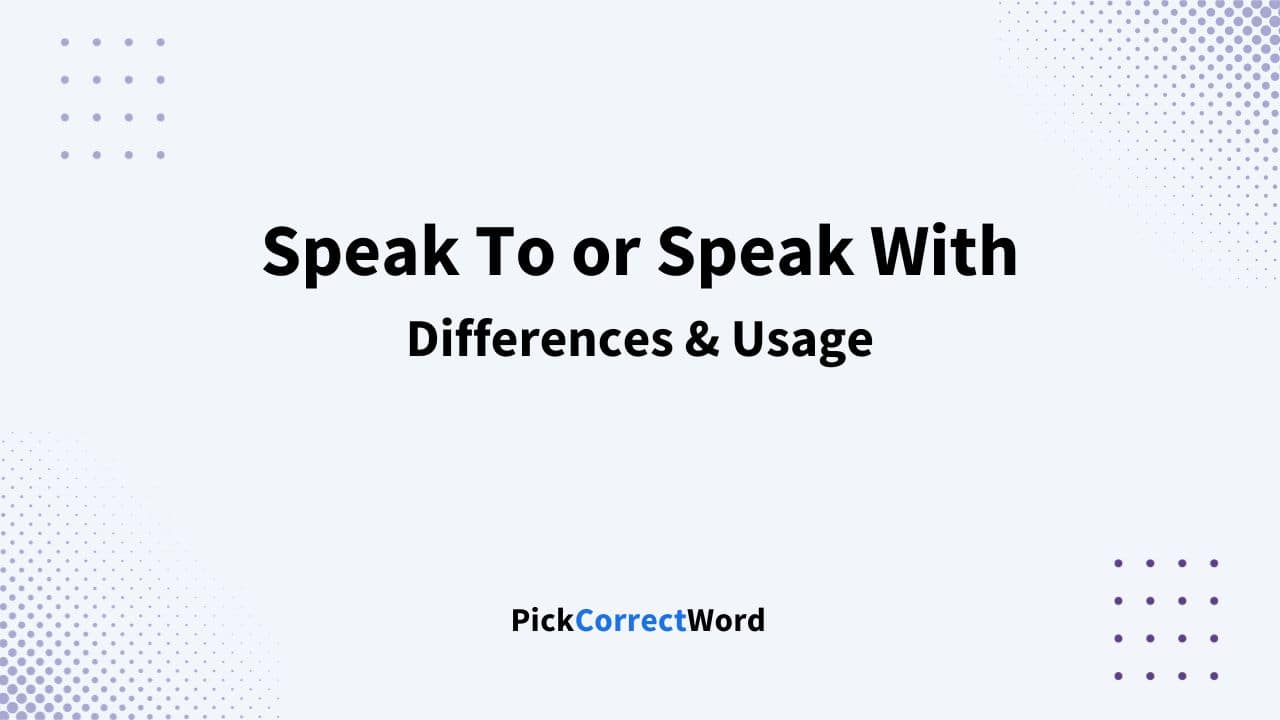If you’re learning English, you might be curious whether to use the phrase “speak to” or “speak with”. Both are used when talking about having a conversation with someone.
Although they’re often used in the same way, they do have slightly different meanings.
“Speak to” is usually used when one person is talking to another person or a group.
“Speak with” suggests a more back-and-forth conversation between two or more people.
But don’t worry, in most cases, you can use either phrase and people will understand what you mean.
Speak To or Speak With: Difference and Usage Examples
The main thing to remember is that “speak to” usually means one person is doing all the talking, while “speak with” suggests a two-way conversation where everyone is participating.
When you “speak to” someone, it’s often more of a one-sided conversation. The other person is mostly just listening. It’s like when a boss gives instructions to an employee, or a teacher talks to a student.
On the other hand, when you “speak with” someone, it’s a two-way conversation. Both people are sharing their thoughts and exchanging ideas. This is the kind of chat you’d have with your friends or colleagues when you’re discussing something together.
Prepositional Use in Language
When using the phrases “speak to” and “speak with”, the prepositions “to” and “with” can change how the conversation is seen:
- “To”: This word shows direction, like a one-way street. It’s used when one person is doing most of the talking, like in “speak to”.
- “With”: This word shows connection or teamwork. It’s used when there’s a back-and-forth exchange of ideas, like in “speak with”.
Formal vs Informal Situations
In more official situations, like business meetings or job interviews, you’d usually say “speak to”. This phrase gives a sense of importance and formality that fits these situations.
For instance, you might say:
- “I need to speak to my boss about the next big project.”
But, for more relaxed situations or friendly chats, you’d use “speak with”. This phrase suggests a laid-back and open mood, which is great for social gatherings or casual talks.
So, you could say:
- “Let’s speak with our buddies about the weekend bash.”
One-Way vs. Two-Way Conversations
Another way to tell apart “speak to” and “speak with” is by looking at the kind of chat you’re having.
When you “speak to” someone, it usually means one-way conversation, where you’re doing most of the talking, and the other person is mainly listening. This is often the case when you’re presenting something or giving directions.
For example, you might say:
- “The teacher will speak to the class about the new homework.”
On the other hand, “speak with” suggests a two-way conversation where everyone is chipping in with their thoughts and ideas. This phrase is a good fit when there’s a lot of back-and-forth in the conversation.
So, you could say:
- “I need to speak with my team member about our shared task.”
Examples of Using “Speak to” in a Sentence
“You need to speak to your teacher about your homework.“
“Mary wants to speak to John about their upcoming project.“
“I have to speak to my manager regarding my schedule.“
“Can you speak to the customer service representative regarding the issue?“
“Please speak to the pharmacist about your medication.“
“He chose to speak to the audience about his experiences.“
“Before making a decision, you should speak to a financial advisor.“
“She decided to speak to a therapist about her concerns.“
“I will speak to the store manager about the product recall.“
“You should speak to your neighbors about the shared yard space.“
Examples of Using “Speak with” in a Sentence
“You may want to speak with your manager regarding the new project assignment.“
“I had the chance to speak with the author after their book signing event.“
“Before making a decision, take time to speak with a financial advisor to review your options.“
“If you have any questions about the product, don’t hesitate to speak with customer support.“
“When you’re lost in a foreign city, it’s helpful to speak with a local to get directions.“
“As a team leader, make sure to speak with each team member during weekly meetings to stay updated on their progress.“
“To improve your language skills, try to speak with a native speaker regularly.“
“Always remember to speak with your partner if you feel that something is bothering you in the relationship.“
“During parent-teacher conferences, it is essential for parents to speak with their child’s teachers to discuss academic progress and any concerns.“
“Before submitting your application, you might want to speak with a career counselor to review your resume and cover letter.“
UK vs US English: Which phrase is more common (speak to or speak with)?
In British English, people often say “speak to”. So someone from the UK might say “I need to speak to John,” and it means the same as “I need to speak with John.”
On the other hand, in American English, people usually say “speak with”. For instance, an American might prefer to say “Can I speak with you?” instead of “Can I speak to you?”
- UK English: “speak to” is more common
- US English: “speak with” is more common
Still, you can use both phrases interchangeably, and which one you pick might depend on your personal style or how formal you want to be.


